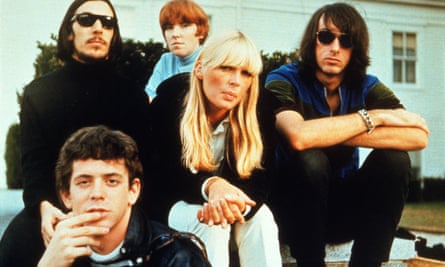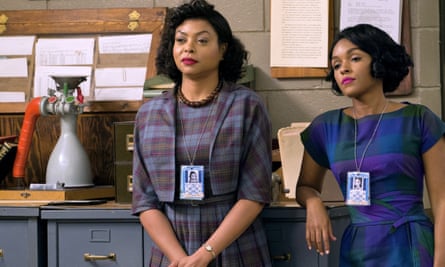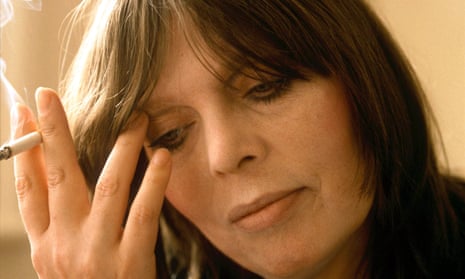On paper, Nico – the Warhol acolyte, singer and fashion model who added international exoticism to the grungy downtown hip of the Velvet Underground – would seem to be perfect biopic material.
With her glowering, angular looks and smoky drone of a voice, she was unlike anyone else around at the time. She had a string of romances with beautiful, troubled men. Further boxes are ticked on the biopic checklist by the fact that she struggled with demons – heroin was her drug of choice.
But Nico, 1988, the daringly unconventional biopic by Italian director Susanna Nicchiarelli, which has just opened in the US, is not about the singer in her iconic phase. Instead it deals with the last two years of her life: Nico prefers to go by her birth name, Christa Päffgen; she performs avant-garde proto-goth dirges while scowling through her fringe in European dive bars; the decades of addiction have taken their toll, but she doesn’t care: “I wasn’t happy when I was beautiful.”
Nico’s value to Warhol was inextricably linked to the way she looked. When asked what became of Nico after she left his studio, the Factory, Warhol was dismissive: “She became a fat junkie and disappeared.” But what interested Nicchiarelli was her resilience. Unlike other Warhol superstars – such as Edie Sedgwick and Candy Darling – who crashed and burned once their 15 minutes of fame were snatched away, Nico reclaimed herself. Talking at the Rotterdam film festival, Nicchiarelli said, “The intriguing thing about Nico was that she survived. She was so much stronger.”

The focus of this film – on unglamorous middle age rather than gilded youth – is significant. It is representative of a change in the way biopics – for so long dominated by white, male stories – approach female subjects. There’s no doubt that we are in the midst of a particularly rich period for female-led real-life dramas. Alongside independent productions such as Nico, 1988 and Christine (about TV news anchor Christine Chubbuck), Hollywood has also got in on the act. The last 18 months have seen the release of studio productions such as I, Tonya, Battle of the Sexes, Molly’s Game, Queen of Katwe and Hidden Figures.
It’s tempting to assume that this wealth of female-led biopics represents a surge in the number of films about women that have been produced. A look forward to the coming award season certainly seems to back that up. Forthcoming female biopics include those of two writers, two queens, a spy, a wrestler and a US Supreme Court Justice.
But statistics tell a different story. Just last week, the University of South California’s Annenberg Inclusion Initiative, which analyses the representation of women, along with people of colour, LGBT characters and characters with disability in cinema, released a study entitled Inequality in 1,100 Popular Films, which covers the top 100 movies each year from 2007 through to 2017 and shows no significant statistical improvement in the representation of women.
Study co-author Katherine Pieper attributes the impression that there are more female-led films than there actually are to “the availability heuristic”. This, she says, is “the tendency of people to overestimate the occurrence of a particular item because of examples that easily come to mind”.
But there is something else at play. What is harder to define, but does seem like a genuinely positive trend, is a shift in the narratives of female-led biopics, a change in the kind of stories that get told. Previously, the main criterion for biopic treatment seemed to be a set of male genitalia, and failing that, royal blood or a singing career. The Hollywood approach suggested that women’s stories were more valuable if youth and beauty were key plot points. And for some reason, doomed and tragic tended to be an easier sell to financiers than difficult and complex.
Now, bad behaviour is not just permitted, it’s positively encouraged. Last year saw Molly’s Game showcase poker queen and FBI target Molly Bloom, while I, Tonya got under the sequined Lycra of disgraced figure skater Tonya Harding. Flawed female characters continue to exert a fascination. This autumn will see Can You Ever Forgive Me?, starring Melissa McCarthy, which tells of American author turned literary forger and thief Lee Israel. And Red Joan, starring Judi Dench, is inspired by the life of the KGB’s longest-serving British spy, Melita Norwood.

Female biopics are not shying away from racial and sexual politics. Hidden Figures, which explored the role of a team of female African American mathematicians in the Nasa space programme, was hugely successful. And Mimi Leder’s On The Basis Of Sex, about Ruth Bader Ginsburg, her struggles for equal rights and her journey to become a US supreme court justice, is already tipped for the awards circuit this year.
Although suspicious of the subjective nature of biopics and their often stodgy approach, Mia Bays, director-at-large of Birds’ Eye View, which campaigns for gender equality in film, concurs. “It seems the net has been cast a little wider of late and the biopic is no longer the preserve of the damaged musician and royalty,” she says. “The 1970s appears to be a recurring period in terms of female-led biopics, and may say more about the times we are living in now – as the fourth wave of feminism surges, we look back to an earlier age for answers.”
While cinema is notoriously slow to react to social movements, it’s hard not to view the new wave of female-led biopics through the lens of the post-#MeToo era. There is a fresh awareness not only of the treatment of women within the film industry but also of the telling of their stories. The term “inclusion rider” (a contract term requiring diversity in cast and crew) has entered industry consciousness, and lobbying groups such as Era 50/50 and Women and Hollywood are calling for equal representation for women in front of and behind the camera.
While we are yet to see what effect this all has on the films that get made, it has certainly had an effect on the audience reaction to them. Bays says: “We need to keep up the pressure to tell more women’s stories as there’s a hunger out there for them – we hear and see it every day in our work.”

Comments (…)
Sign in or create your Guardian account to join the discussion